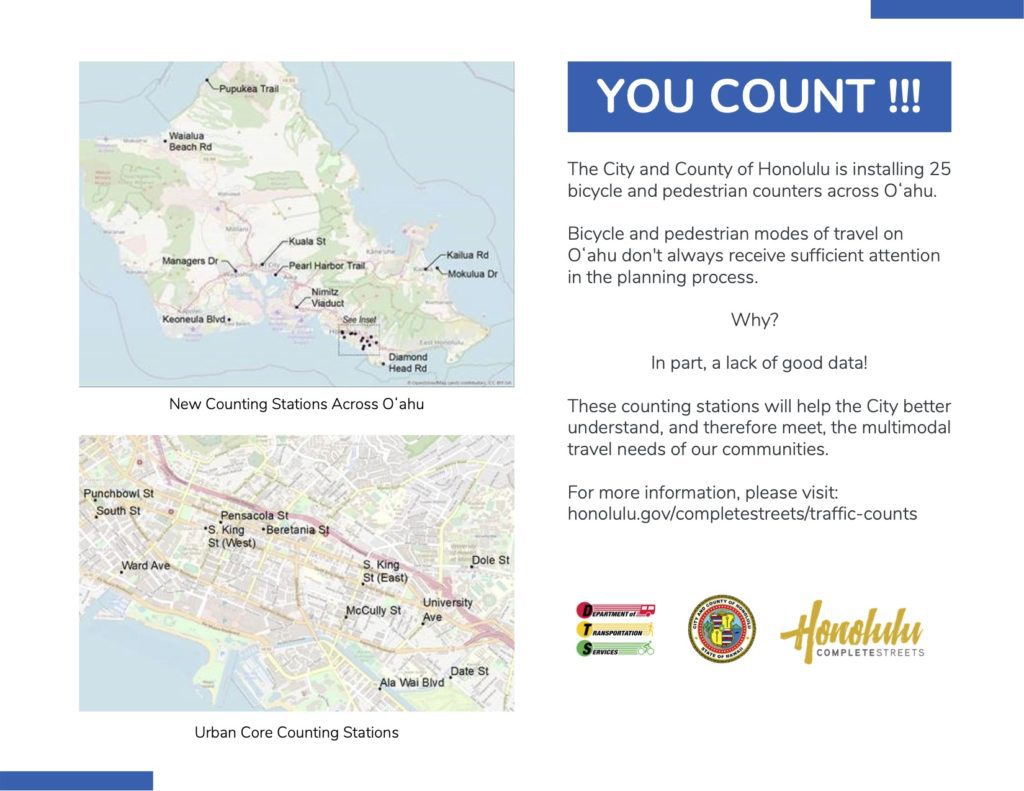Sensors to count pedestrians, cyclists on Oahu routes
Star Advertiser
By Jack Truesdale • Nov. 9, 2022
In an ongoing push for safer streets, Honolulu Hale this week began installing sensors to count pedestrians and cyclists on routes across the island.
The city Department of Transportation Services hopes that data on how frequently people use the 14 streets in urban Honolulu and 11 beyond city limits will inform plans for future bike lanes, bike racks and an expanded sidewalk area, according to a city news release.
In Honolulu the sensors, known as active transportation monitoring devices, or ATMs, will be installed on Waialae, Kalakaua, University and Ward avenues; Date, Dole, McCully, South King (east), South King (west), Beretania, Pensacola, South and Punchbowl streets; and Ala Wai Boulevard. The other locations include Kailua Road, Mokulua Drive, Nimitz Viaduct, Pearl Harbor Trail, Kuala Street, Managers Drive, Keoneula Boulevard, Waialua Beach Road and Pupukea Trail.
“The goal of the counters is ultimately to get a better idea of where the current usage is,” said Hawaii Bicycling League Executive Director Travis Counsell. Regarding the data generated, he said, rather than deciding “a ‘yes’ or ‘no’ for a project,” it will signal, “There’s a lot of people here, we can improve this.”
Eventually, the new technology might help the city save some money.
The locations were selected “to be a representative sample … that can be applied to short-term counts collected at any location on Oahu,” DTS spokesperson Travis Ota wrote in an email. Members of the public and city traffic engineers request these manual counts that, “depending on the location and duration,” can cost about $2,000 each, Ota said.
The cost of installing the ATMs is $661,376, according to Ota. The city will pay $145,376, and the Federal Highway Administration will cover up to 80% of the cost, he said, which is about the remainder.
In 2006 a majority of voters elected to revise the County Charter to make Oahu friendlier for pedestrians and cyclists. In 2012 the City Council adopted Ordinance 12-15, known as the “Complete Streets ordinance,” to, among other goals, better accommodate people traveling on foot and bicycle.
But it would be tricky to say just how pedestrian- and bike-friendly Oahu is without any data.
“The city has an ordinance that basically says you have to take everybody, not just vehicles, every person hitting the road into account when they’re doing all these projects or improvements,” Counsell said. “Having data, that’s the baseline for this larger ‘Complete Streets’ approach.”
Transportation Services can use the data alongside monitoring of other modes of transportation “to obtain a holistic understanding of travel patterns in Honolulu,” the news release said. Taken together, “the data that DTS collects through the ATM devices will help the city measure our progress toward making Honolulu a more pedestrian and bike-friendly city,” the release said.
To detect cyclists, the ATMs use wire loops in the pavement to sense a bicycle (or other metallic object) passing above. For pedestrians a post with a “pyro-electric” sensor detects changes in temperature as people pass by it.
The city advertised the contract in November 2020, received two proposals and awarded it in May 2021 to Honolulu-based engineering firm SSFM, according to Ota. Eco-counter, a French company, will provide the counting technology, Ota said.
“Historically, HBL helps the city by doing basically a bike count at certain intersections,” said Counsell. The ATM, he said, “provides a much more long-term data source.”
MONITORING FOR SAFETY
To count foot and bicycle traffic, the city will begin installing sensors known as active transportation monitoring devices, or ATMs, in locations along the following roadways:
Honolulu
Waialae, Kalakaua, University and Ward avenues; Date, Dole, McCully, South King (east), South King (west), Beretania, Pensacola, South and Punchbowl streets; and Ala Wai Boulevard.
Other locations
Kailua Road, Mokulua Drive, Nimitz Viaduct, Pearl Harbor Trail, Kuala Street, Managers Drive, Keoneula Boulevard, Waialua Beach Road and Pupukea Trail.


